The topic of “green building practices” is becoming increasingly relevant in today’s world. As such, it’s a common theme that might appear in the IELTS Writing Task 2 exam. Understanding this topic and how to write effectively about it can significantly improve your IELTS score.
Potential IELTS Writing Task 2 Questions
Here are some examples of how the topic of green building practices could be presented in an IELTS Writing Task 2 question:
- Many people believe that the benefits of constructing green buildings outweigh the drawbacks. To what extent do you agree or disagree? (Opinion Essay)
- The construction industry has a significant environmental impact. What measures can be taken to make construction more sustainable? (Problem/Solution Essay)
- Discuss the advantages and disadvantages of implementing green building practices in developing countries. (Advantages/Disadvantages Essay)
Sample Essay Analysis:
For this guide, we will analyze the first question, which is an opinion essay:
Many people believe that the benefits of constructing green buildings outweigh the drawbacks. To what extent do you agree or disagree?
Essay Analysis
This question requires you to clearly state your opinion on the statement and then provide relevant reasons and examples to support your viewpoint. Remember to maintain a clear and logical structure throughout your essay.
Model Essay
The increasing awareness of environmental issues has led to a surge in sustainable practices across various sectors, with the construction industry being no exception. This has spurred the development of green building practices, which aim to minimize the environmental impact of buildings. While some may argue that these practices have drawbacks, I firmly believe that the benefits of constructing green buildings far outweigh any disadvantages.
Firstly, green buildings are designed to be energy-efficient, primarily through the incorporation of renewable energy sources like solar panels and efficient insulation. This reduces reliance on fossil fuels, leading to lower greenhouse gas emissions and mitigating the effects of climate change. For instance, studies by the U.S. Green Building Council have shown that LEED-certified buildings consume 25% less energy and emit 34% fewer greenhouse gases compared to conventional buildings.
Secondly, green building practices promote water conservation. By implementing innovative water-saving technologies such as rainwater harvesting systems and low-flow fixtures, these buildings significantly reduce water consumption. This is particularly crucial in regions facing water scarcity, where such practices can alleviate strain on local water resources.
Furthermore, green buildings prioritize the use of sustainable and recycled materials, minimizing the environmental impact associated with the extraction and transportation of traditional building materials. This not only conserves natural resources but also reduces pollution and waste generation.
Opponents of green building might argue that the initial construction costs are higher. While this may be true to some extent, the long-term economic benefits, including reduced energy and water bills, quickly offset the initial investment. Moreover, governments often provide incentives and tax breaks for green building projects, further mitigating the financial burden.
In conclusion, the benefits of constructing green buildings are undeniable and far outweigh any perceived disadvantages. By promoting energy efficiency, water conservation, and sustainable material usage, green buildings pave the way for a more environmentally responsible and sustainable future. As such, I wholeheartedly agree that the advantages of green building practices are paramount and should be widely adopted. (Word count: 319)

Writing Tips
- Vocabulary: Use specific vocabulary related to construction, environment, and sustainability. Avoid generic words and aim for precision.
- Grammar: Pay close attention to verb tenses when discussing past, present, and future implications of green building.
- Examples: Support your points with concrete examples, statistics, or case studies to enhance your argument.
- Connectors: Use a range of linking words and phrases to ensure a smooth flow of ideas.
Vocabulary
- Mitigate (verb) /ˈmɪt.ɪ.ɡeɪt/: To make something less harmful, serious, or unpleasant.
- LEED-certified (adjective) /liːd-/: Leadership in Energy and Environmental Design, a globally recognized green building rating system.
- Rainwater harvesting (noun) /ˈreɪnˌwɔː.tər ˌhɑːr.vɪ.stɪŋ/: The process of collecting and storing rainwater for later use.
- Low-flow fixtures (noun) /ˌloʊ.floʊ ˈfɪks.tʃərz/: Appliances and fixtures designed to use less water than conventional models.
- Offset (verb) /ˌɔːfˈset/: To balance one influence against an opposing influence, so that there is no great difference as a result.
Conclusion
“Green building practices” is a multi-faceted topic with ample scope for discussion in the IELTS Writing Task 2. By familiarizing yourself with the relevant vocabulary, understanding the potential question types, and practicing writing well-structured essays, you can confidently tackle this topic and improve your overall IELTS score. Remember to practice writing essays on other potential topics related to sustainable development and environmental conservation for comprehensive preparation.